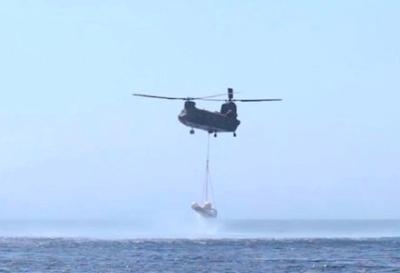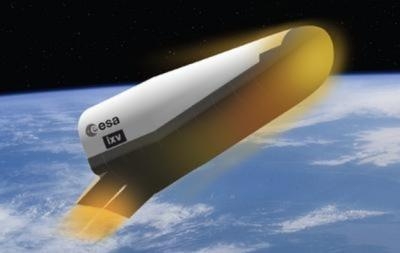Wed, Jun 26, 2013
Released From Nearly 10,000 Feet Off The Coast Of Italy
ESA’s experimental reentry vehicle passed its milestone descent and landing test on last week at the Poligono Interforze Salto di Quirra off the east coast of Sardinia in Italy. The full-scale Intermediate eXperimental Vehicle (IXV) prototype was released from an altitude of 3000 m (about 10,000 feet) by a helicopter, falling to gain speed to mimic a space mission before parachute deployment. The parachute slowed IXV for a safe splashdown in the sea at a speed below 7 m/s (23 f/s). This last step in a series of tests shows that IXV can be recovered safely after its mission into space.

The IXV project is developing and flight-testing the technologies and systems for Europe’s future autonomous atmospheric reentry vehicles. It will be launched by ESA next year on Vega, Europe’s new small launcher, into a suborbital path. It will reenter the atmosphere as if from a low-orbit mission, testing new European reentry technologies during its hypersonic and supersonic flight phases.
Previous campaigns included several water impact tests at CNR–INSEAN, a marine-engineering research institute in Rome, Italy. An instrumented subscale prototype was released at various angles and speeds to assess the best configuration for minimum impact loads.
At the Yuma Proving Ground in AZ, the multistage supersonic parachute was qualified up to the opening of the main subsonic stage. Building on these, Wednesday’s test started with the redeployment of the main subsonic parachute followed by: cutting the two ablative thermal protection covers of the parachute bridles, firing the 16 non-explosive actuators to release the four panels covering the floatation balloons, jettisoning the panels, detecting the water impact, deploying the beacons, and receiving the signal from the Cospas–Sarsat satellite network pinpointing the prototype bobbing in the sea.
An anomaly in inflating the balloons will be investigated. The vehicle was recovered from the sea and taken to land for detailed inspections and analysis.

This test highlights the importance of early inflight verification to secure a robust space vehicle design, confirming the technical direction and possibly suggesting further improvements.
“Our special thanks go to the Italian Defense and the Italian Aerospace Research Centre (CIRA) for the commitment and the excellence exhibited in performing complex air–sea–ground operations enabling the successful challenging descent and landing system test,” noted Giorgio Tumino, IXV Program Manager.
On IXV’s flight next year, the suborbital vehicle will separate from its Vega launcher at an altitude of about 200 miles. IXV will coast to 267 miles and then begin its reentry phase, recording experimental data from a large number of conventional and advanced sensors.
The entry speed of around 4.6 m/sec at an altitude of 74.5 miles will create the same conditions as those for a vehicle returning from low orbit. The mission, lasting more than 2 hours, will end with splashdown in the Pacific Ocean to await recovery and analysis.
(Images provided by ESA)
More News
Aero Linx: Model Aeronautical Association of Australia MAAA clubs are about fun flying, camaraderie and community. For over 75 years, the MAAA has been Australia’s largest fl>[...]
Touchdown Zone Lighting Two rows of transverse light bars located symmetrically about the runway centerline normally at 100 foot intervals. The basic system extends 3,000 feet alon>[...]
“Discovery and innovation are central to our mission at Virgin Galactic. We’re excited to build on our successful record of facilitating scientific experiments in subor>[...]
How To Get A Story On Aero-TV News/Feature Programming How do I submit a story idea or lead to Aero-TV? If you would like to submit a story idea or lead, please contact Jim Campbel>[...]
Student Pilot Reported That During Rotation, “All Of A Sudden The Back Of The Plane Kicked To The Right..." Analysis: The student pilot reported that during rotation, “>[...]
 ANN's Daily Aero-Linx (05.02.24)
ANN's Daily Aero-Linx (05.02.24) ANN's Daily Aero-Term (05.02.24): Touchdown Zone Lighting
ANN's Daily Aero-Term (05.02.24): Touchdown Zone Lighting Aero-News: Quote of the Day (05.02.24)
Aero-News: Quote of the Day (05.02.24) ANN FAQ: Contributing To Aero-TV
ANN FAQ: Contributing To Aero-TV NTSB Final Report: Cirrus Design Corp SR20
NTSB Final Report: Cirrus Design Corp SR20




